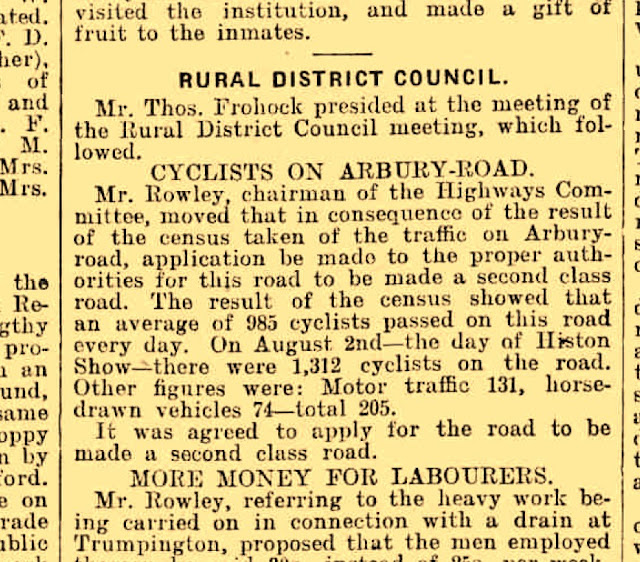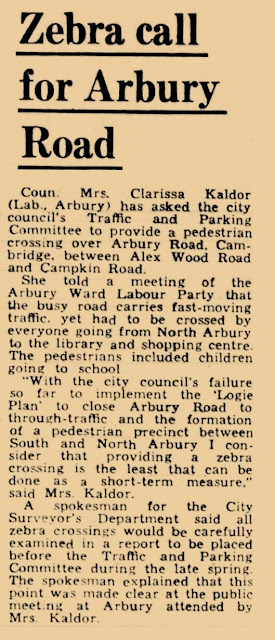One of the local history displays at the Arbury Court shopping centre. The origins of Arbury, of course, pre-date those of Chesterton by centuries. The display also mentions the Roman finds in the old Arbury Meadows/Manor Farm fields, including a Roman villa. More were found last year, including a plesiosaur bone - perhaps a prized curiosity of a Roman resident.
The original Arbury Road connected the Milton (or Ely) Road to the Histon/Cambridge Road until the late 1970s, when the dead end King's Hedges Road, which led north of the guided busway to King's Hedges, a fifty-eight acre farm (what we term here the REAL King's Hedges), was redirected and expanded across the old Arbury/Harborough Meadows/Manor Farm and lopped off the end of Arbury Road as part of the A14 motorway development.
Before Manor Farm, much of the land north of Arbury Road was known as the Arbury/Harborough Meadows, North Arbury/Harborough Furlong, West Arbury/Harborough Furlong, etc. A swathe of land south of Arbury Road was also part of the Arbury/Harborough Meadows, and there was also a property north of the road at the Histon Road end, revealed in a 1829 newspaper advertisement, called 'Arbury Hedges'. The Arbury name was derived from the iron age earthwork at Arbury Camp, a landmark feature for over two thousand years. Part of the earthwork bank is still clearly defined at Orchard Park (originally Arbury Park and, before that, Arbury Camp Farm) as Ring Fort Road. Harborough was a variation on the Arbury name and the two were used concurrently and interchangeably.
Fast forward to 1969, and things were very different. North and South Arbury had sprung up, north and south of Arbury Road, and Arbury community spirit was running high, with plans and fundraising for the Arbury Adventure Playground on the Nuns Way playing field, and for the Arbury Community Centre and Arbury Town Park in Campkin Road. The Arbury Carnival still lay a few years in the future, as did the Arbury Is Where We Live! book.
The early 21st Century and the Arbury Road crossing has been a landmark for decades. The old Manor Community College buildings are still standing, but demolition work is beginning. The Manor had been renamed North Cambridge Academy by this time and work was soon to begin on the new buildings. In 1923, the view would have shown a country road. The Manor School/NC Academy, occupy part of the Manor Farm's old Park Meadow.
There is conjecture that the historic Arbury Road is actually based on a track or road which was part of an iron age network, leading from Arbury Camp to the river and other places. Modern archaeological discoveries, which point to Arbury being a fort and therefore of considerably more importance than the iron age equivalent of a village, lend credence to the notion.
But, leaving all that aside, Arbury is certainly the only road name in Cambridge city with prehistoric links.
Arbury Road was rural - until quite recent times. Take a look at the maps above and below and try to conjure up an image of the road, bordered by the old Leys Laundry, the old Arbury Meadows, Furlongs, etc, north of the road (later Manor Farm), Arbury Camp Farm and so on. In 1923, the Chesterton Rural Council had Arbury Road on its agenda as a 'busy road'. Should it be upgraded to a 'Second Class' road?
Can you imagine today the users of the road in one day amounting to 1,312 cyclists, 131 motor vehicles and 74 horse-drawn vehicles (this was on a particularly busy day with the Histon Show taking place) - and that being conducive to an application for the road to be upgraded?
The road was an important one for workers at Chivers in Histon. One contributor to the Arbury Archive in the 1980s shared her early 20th Century memories:
Mrs Muriel Wiles:
Click on the text if you would like to read the full article later.
Arbury Road still ran from the Histon/Cambridge Road to Milton Road, as it always had (the motor vehicle powered 'King's Hedges' depredations across the old Arbury Meadows, lopping off the Histon end of Arbury Road, had not yet come to pass) and there was talk of closing Arbury Road to through traffic altogether. We'll cover all that in later articles, but the high volume of traffic using Arbury Road in 1969 created difficulties for North Arbury residents who wished to cross from there to South Arbury and the Arbury Court shopping centre, library, etc, for school children and, no doubt, others.
Mrs Clarissa Kaldor, Labour city councillor for Arbury Ward (which then covered the entire historic Arbury area) thought the least the council could do was install a pedestrian crossing on Arbury Road between North and South Arbury. The suggested location was 'between Campkin Road and Alex Wood Road'. Alex Wood Road? Yes, until the building of the large supermarket at Arbury Court (now Budgens), Alex Wood Road terminated at Arbury Road.
A crossing was eventually placed by Arbury Court itself.







Comments
Post a Comment